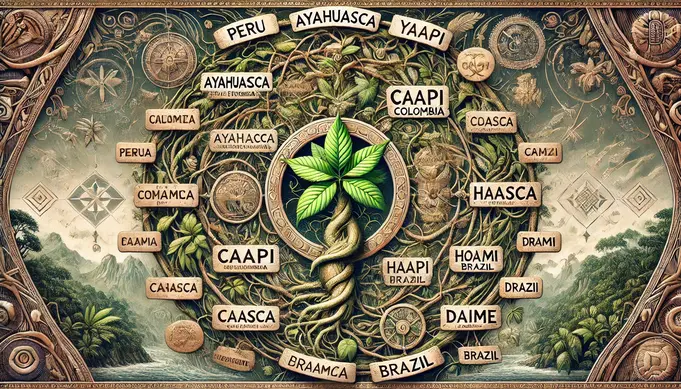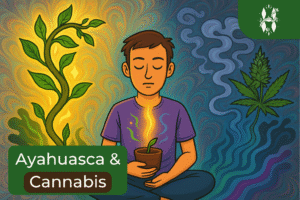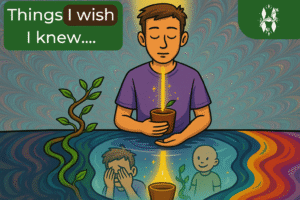You might have come across the term “Yagé” multiple times while traveling through Colombia or researching Ayahuasca in this part of South America. Ayahuasca and Yagé can be used interchangeably, as they both refer to the same plant medicine. In this blog, we’ll break down what sets these two terms apart and explore their similarities and distinctions.
Key takeaways
- There are many similarities and in some ways “Yagé” and “Ayahuasca” are interchangeable and are only a different word used for the same plant medicine.
- Ayahuasca is often connected to the nurturing and wise Grandmother Spirit, guiding users through introspection and healing, while Yagé is linked to the strong and grounding Grandfather Spirit.
- The indigenous often view Ayahuasca and Yagé as neutral spirits that present themselves in the way that the individual needs.
Table of Contents
“The indigenous often view Ayahuasca and Yagé as neutral spirits that present themselves in the way that the individual needs.”
Feminine Ayahuasca vs. Masculine Yagé vs. Neutral Spirit
In Spanish, words ending in “a” are typically feminine, like “casa” (house). Similarly, Ayahuasca is considered a feminine word, and many people refer to it as a (Grand-) Mother spirit or energy. On the other hand, words ending in “o” or “e” are masculine, with “Yagé” falling under this category. In Colombian tradition, Yagé is often referred to as “Abuelo Yagé” (Grandfather Yagé).
However, it’s important to note that indigenous perspectives on Ayahuasca and Yagé can be more nuanced. Many indigenous communities view the spirit of these plants as neutral, allowing them to present themselves in the way that the individual needs.
To some, the spirit may appear as a (Grand-) Mother, especially when there is significant healing needed in relation to the feminine. To others, the medicine might manifest as a more masculine energy, guiding them through discipline, rules, or personal growth.
Personally, I’ve experienced a lot of lessons about masculinity through drinking Yagé, but I’ve also seen many participants in our ceremonies connect deeply with the Mother Ayahuasca. It’s important to emphasize that when you come to drink Yagé in Colombia, you won’t necessarily be limited to experiencing only a masculine energy.
The medicine will present itself in the way that best serves your process, whether that involves the warmth of the Mother or the strength of the Grandfather. The spirit of the medicine knows what you need and will guide you accordingly.
Find out if Ayahuasca is right for you
- Will you be safe physically and emotionally?
- How will you be supported in the ceremony?
- How do the facilitators handle difficult situations?
- How will you be able to process the experience?
- You want change, but will your life be unrecognizable after Ayahuasca?
+ 13 things to consider before drinking Ayahuasca?
In the West, you often hear that you need to “surrender” to your Ayahuasca experience. This means allowing the medicine to guide you through the ceremony, not fighting it, but flowing with where it takes you. Interestingly, the vocabulary used by indigenous people is more about “aguantar,” which translates to “endure.” This term is often directed toward the facilitators, emphasizing the inner strength required to “withstand” Ayahuasca’s effects so that one can perform the necessary tasks during the ceremony without being overwhelmed. Another common term is “fortalecer,” meaning to fortify or strengthen, which carries a more masculine undertone.
What is Yagé: Macho Culture in Colombia
The idea of Ayahuasca or Yagé being considered masculine might also be influenced by the “macho” culture present in Colombia. While this isn’t something that’s openly discussed, it’s a cultural undercurrent that can shape perceptions. For example, not too long ago, women in indigenous tribes were legally obligated to give their income to their men, highlighting the presence of this “macho” culture in ways that might not be immediately apparent to someone from the West.
“The name Yagé is used in Colombia not because of a particular method of making the brew, but because it’s the term that’s culturally rooted in that region.”

What is Yagé?
Cultural vs Scientific Understandings of the Medicine
When exploring the differences between Ayahuasca and Yagé, it’s common to find information online that points out the specific plants used in different regions. In Peru, the Ayahuasca brew is typically made with the Caapi vine (Banisteriopsis caapi), which contains MAO inhibitors. The DMT-containing plant is usually Psychotria viridis, known as chacruna. In Colombia, however, the DMT-containing plant is often identified as Diplopterys cabrerana, known as chaliponga, chagro, or chagropanga.
However, it’s important to understand that these distinctions, while helpful, might not be as clear-cut as they seem. The indigenous way of working with these plants doesn’t necessarily align with the scientific or systematic approach we often take in the West. For indigenous communities, the emphasis is not on scientific names or consistency across regions. When I spoke with Mama Concha, a respected elder, she didn’t know the specific plant used in Peru and mentioned that scientific names aren’t a part of their tradition.
In many indigenous cultures, knowledge is passed down orally, and the focus is on the spiritual connection with the plants rather than categorizing them in a scientific manner. This means that while different regions might refer to the plants by different names, they could still be talking about the same or similar plants. The nuances of how these plants are understood and named are deeply rooted in the cultural and spiritual practices of the people who use them, rather than in the consistency or classification we might expect from a scientific or Western perspective.
Interestingly, when you talk to the indigenous about DMT and the idea that the effects of Ayahuasca are primarily due to the chemical absorption of this compound in the body, they would find this notion amusing. From their perspective, reducing the profound experiences of Ayahuasca to mere chemical reactions oversimplifies the deep spiritual connection they have with the plant.
The Nuances of the Names: Ayahuasca vs Yagé
When researching Ayahuasca and Yagé online, you might come across explanations that suggest the names of the brew are tied to specific preparation methods. For example, it’s often said that in Peru, Ayahuasca is prepared by leaving the bark on the vine, while in Ecuador, Yagé is prepared by removing the bark first. This kind of information can give the impression that the name “Yagé” is directly linked to this specific preparation method, and “Ayahuasca” to another.
However, the reality is more nuanced. In the tradition that I follow in Colombia, we don’t remove the bark from the vine, yet we still refer to the brew as Yagé. This approach is more similar to the Peruvian method of preparing Ayahuasca than to the supposed Ecuadorian method of preparing Yagé. This example shows that just because something is written online doesn’t make it a definitive rule or universal truth.
The use of the names “Ayahuasca” and “Yagé” is more about cultural and regional identity than about strict differences in preparation. The name Yagé is used in Colombia not because of a particular method of making the brew, but because it’s the term that’s culturally rooted in that region. The preparation methods can vary, even within the same country, and these differences don’t necessarily change the name of the brew. This highlights the complexity and fluidity of indigenous traditions, where practices are adapted to fit the needs of the community, rather than adhering to rigid, universally recognized standards.
So, while online resources can be helpful, they often oversimplify or standardize practices that, in reality, are much more diverse and context-dependent. It’s important to approach these topics with an understanding that what you read might be one perspective, but it’s not the whole picture. Indigenous traditions are living, evolving practices, and the names and methods associated with Ayahuasca and Yagé reflect this dynamic nature.
Icaros vs. “Rezos Sagrados de Yagé”
In Peru, Ayahuasca ceremonies are often accompanied by Icaros – sacred songs that the ayahuasqueros (Ayahuasca shamans) sing during the ceremonies. These Icaros are believed to be received from the plant spirits themselves and serve as powerful tools to guide participants through their Ayahuasca journey. The Icaros are deeply embedded in the Peruvian tradition and are a key part of how the medicine is experienced in that region.
In contrast, in Colombia, where the medicine is more commonly referred to as Yagé, the tradition differs. Instead of Icaros, Colombian shamans use what are known as “rezos sagrados de yagé,” or sacred prayers of Yagé. These prayers are not pre-composed or learned in the same way as Icaros. Rather, they are believed to come directly to the shaman during their Ayahuasca state, often as spontaneous expressions of the connection with the Yagé spirit. Many of these prayers are also passed down through generations, carrying the wisdom and spiritual guidance of the elders.
This difference in ceremonial practice reflects the broader distinction between how the medicine is referred to and understood in these regions. In Peru, the term “Ayahuasca” is used, and the tradition of Icaros plays a central role in the ceremonies. In Colombia, the medicine is known as Yagé, and the focus is on the sacred prayers that emerge from the direct interaction with the spirit of the plant. These prayers are a vital part of the Colombian tradition, emphasizing the personal and immediate connection between the shaman and the Yagé spirit, rather than relying on a set of established songs.
It’s important to note that the rezos sagrados de yagé – the sacred prayers used in Colombian Yagé ceremonies – don’t have to be in Spanish or the indigenous languages. These prayers can come to the facilitator or shaman in any language and are considered just as authentic, as long as they arise from the essence of the Yagé. The language is secondary to the spiritual connection and the authenticity of the prayer. What matters most is that the prayer reflects the shaman’s direct communication with the spirit of the plant, embodying the wisdom and guidance received during the ceremony.
Must read blog: Ayahuasca vs San Pedro

How Environmental Differences Might Affect the Properties of the Plant
I had a conversation with a researcher who attended our Ayahuasca retreat and she mentioned an interesting observation about cacao: its properties can vary depending on which side of a hill it grows on. This concept, while not directly proven for Ayahuasca, opens up an intriguing line of thought. If the environment – such as soil composition, altitude, climate, and other ecological factors – can influence the properties of one plant, it’s possible that Ayahuasca vines growing in different regions, like Peru and Colombia, might also exhibit slight variations in their properties.
Different Names for Ayahuasca
It’s remarkable to consider how such a powerful plant medicine has been discovered and used by countless indigenous tribes across the Amazon region – spanning Colombia, Brazil, Ecuador, Venezuela, Bolivia, and Peru. These regions cover thousands of miles, with no obvious means of communication between the tribes. Given this, it’s understandable that different cultures have developed their own names for Ayahuasca.
Here are some of the other common names for Ayahuasca:
Ambiwaska: This term is most commonly used by the Inga tribe in Colombia.
Hoasca: A term used in Brazil, particularly within the context of religious ceremonies.
Daime: Associated with the Santo Daime religious tradition in Brazil.
Natema: Used by the Shuar people in Ecuador and Peru.
Nixi pae: A term used by the Huni Kuin (Kaxinawá) tribe in Brazil.
Shori: Used by the Asháninka people in Peru.
La Purga: A name used in various regions to refer to the purgative effects of the medicine.
Mariri: Also commonly used in Brazil.
Each of these names reflects the unique cultural context and traditions of the tribes that use Ayahuasca, illustrating the many ways this medicine is understood and respected across the Amazon.
Must read blog: Ayahuasca ceremony – what to expect
Conclusion
Yagé, known by various names across different regions, is a powerful plant medicine deeply rooted in indigenous traditions. It has been used for centuries as a tool for spiritual healing, personal growth, and connection to the natural world. Whether referred to as Yagé, Ayahuasca, or by another name, this sacred medicine invites us to explore the depths of our consciousness, offering profound insights and healing.
FAQs
What is the difference between Ayahuasca and Yagé?
Ayahuasca and Yagé are essentially the same plant medicine. Ayahuasca is the term commonly used in Peru and other parts of the Amazon, while Yagé is the more common term used in Colombia. Both involve the same core components—the Caapi vine and a DMT-containing plant.
Why is Yagé considered more masculine compared to Ayahuasca?
In Colombian tradition, Yagé is often referred to as “Abuelo Yagé” (Grandfather Yagé), which gives it a more masculine association. This contrasts with Ayahuasca, which is often seen as a feminine spirit or “Grandmother Ayahuasca.” These distinctions are rooted in cultural interpretations, though many believe that the spirit of the medicine presents itself differently depending on the individual’s needs.
Does it matter whether the brew is called Ayahuasca or Yagé?
The name – whether Ayahuasca or Yagé – is less important than the spiritual connection you have with the plant. Different regions may use different names for the same medicine due to cultural and linguistic differences, but these names do not fundamentally change the essence of the plant or its effects. What truly matters in these traditions is the relationship you develop with the spirit of the plant during your journey.





